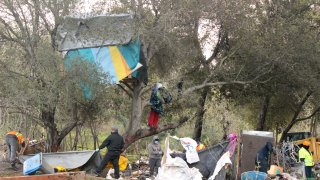
Renovations for San Jose's Coyote Creek Trail may result in the largest homeless camp removals since the city swept the infamous Jungle encampments in 2014.
On Monday, the city began breaking down dozens of tents, treehouses and other makeshift homes, and removing homeless individuals living along the Coyote Creek Trail, a nearly mile-long stretch starting at Olinder Dog Park to where The Jungle homeless encampment officially starts near Story Road.
The Jungle was San Jose's, and arguably the nation's, largest homeless encampment. About 300 people who took shelter along 68 acres of the Coyote Creek Trail were 'swept' , or forcibly removed, in 2014 in an effort to find housing for individuals and reduce to pollution in the creek and environment.
Now, many individuals are back a glaring reminder of the city's struggle to provide affordable housing in one of the richest areas in the world. And it may be just as populated as it was in 2014.
Get a weekly recap of the latest San Francisco Bay Area housing news. Sign up for NBC Bay Area’s Housing Deconstructed newsletter.
This week, the city is only sweeping one side of the Coyote Creek Trail from the dog park to Remillard Court, near Happy Hollows. "I think, a conservative estimate is like 125 people," advocate for the unhoused population Shaunn Cartwright said. "But it could easily be 300 people."
City representatives did not provide on official count, but Cartwright's estimate is based on how many meals she distributes when she visits the camp on Thursdays. "I bring 100 meals with me and you have to assume that some will not be at there when I come and others are not going to walk that steep uphill or see me," Cartwright said.
"I don't even go on the opposite side of the Creek, and others don't cross because it's not easy and I always get through the 100 meals pretty quickly, so you can do the math."
Local
Next week, the city intends to remove the individuals sheltering along the creek from Olinder Dog Park toward William Street. And in November, the city swept Roberts Camp, where 40-50 people took shelter. "When you add it up, yah, it may be as big of a sweep as the Jungle," Cartwright said.
The city says the reason for the homeless camp removals is renovations to the Coyote Creek Trail. "This work involves heavy equipment," city spokesperson Jeff Scott said. "It is unsafe to have people living and sleeping in proximity to a construction site."
The trail renovations have been in the works for years, Scott said, so changing the timeline could have "significant financial repercussions" and impacts on various aspects of city operations.
Those include project funding and contracts and arrangements that affect the hiring of workers, financial commitments to vendors, public access to parks and trails and temporary changes to traffic flow. Scott said funding agreements, such as state or federal grants, for public works projects often have sunset clauses if the money is not spent in the allotted time.
A 2020 update report for trail renovation noted the project received upwards of $300,000 in an Affordable Housing and Sustainable Communities state grant. The rest of the funding will come from the city's annual budget.
The city started planning for the renovations to connect and refurbish 20 miles worth of trails along the creek in 2014 and by 2018, the city had an official plan approved by the department of public works and city manager's office.
But Cartwright said construction is not a good enough reason to break down the homes of those living along the creek and force them to leave. Many of the residents have been living there for years, some even as longer than a decade, Cartwright said.
People built sound structures out of wood and even have proper bedding and couches there. "Some dug out trenches to build a home inside the hill," Cartwright said. "I mean it's ingenious." Those living along the river even built bridges to get across one side of the creek to the other and stairs to walk up and down the steep sides of the riverbend.
"This is their home, they have literally built into it," Cartwright said. She noted that moving unhoused folks during a pandemic was a violation of CDC guidelines and the city's own policy outlined on its website.
But furthermore, she said it puts more homeless people at risk without providing them any solution. "They are just going to move to the other side of the creek, which may cause turf wars, or go onto land that is not under the city's jurisdiction," Cartwright said.
A 38-year-old homeless man named Alex did exactly that. He was living in an empty shed behind the dog park, which was on city property and subject to the abatement, so he was forced to leave. However, he only moved his belongings 20 feet over into land under Caltrain jurisdiction. "I'm staying here for now because the city can't force me to leave here," Alex said.
"I'll stay until I figure out where to go next." In an email Scott said, "Every person living in the encampment near the construction site was offered a shelter or housing opportunity." But when asked did not provide information regarding how many people were offered housing or where they were offered to stay.
But unhoused folks who were moving their belongings Monday morning said they had no idea where they would be going next.
San Jose man Gabriel, who has been chronically homeless for many years, said he and his wife Clarissa want proper housing, but were not offered any. He had built a makeshift home with wood and spray insulation along the creek to provide some form of shelter for them and their two cats.
"We've been here [Coyote Creek Trail] like off and on like four times," Gabriel said. In fact, he was involved in a sweep in the same location about three years ago too, he said. "Sweeps make your life miserable," Gabriel said as he walked his mustard yellow electric scooter away from the encampment. "You have to move your stuff, they only give you three days, and if you don't see the signs, well then all your stuff gets thrown away."
He noted, however, that the staff and treatment from abatement crews this year was much better than it had been during previous sweeps. "These guys at least helped me move my stuff up and were helpful," Gabriel said. "Last time, even when our stuff was bagged, and they can't throw away your bagged stuff, they didn't care and threw it away, even our tent that was packed up."
Scott said the city does not expect more removals during the current portion of the project, which is expected to be completed by August 2021.
However, there are still two portions, Williams Street to Story Road and Phelan to Tully -- that are expected to begin construction later this year, which may mean additional encampment sweeps.
The Coyote Creek Trail should be completed and open to the public by fall 2022.



